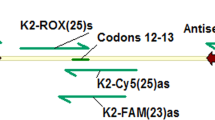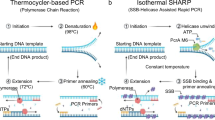Abstract
Probe-based polymerase chain reaction (PCR), a popular method in genetic testing, could be prone to false positive or positively biased results if standards used for positive controls or as calibrants accidentally contaminate samples during analysis. To prevent this, a unique design strategy for nucleic acid standards has been developed. Several in-house designed synthetic standards and corresponding test targets were analysed in specific probe-based PCR assays in the presence of SYTO 82™, an intercalating dye compatible with a probe-labelling FAM (6-Carboxyfluorescein) fluorophore. PCR was followed by melting and fragment size analyses. We showed that a standard can be designed to allow discrimination from the test target in post-PCR melting analysis based on differences in melting temperature (Tm). A good predictor of Tm differences for the paired amplicons was the software package uMelt, but not the length of the amplicons nor guanine-cytosine (GC) content. Tm-based determination can be complimented by electrophoresis to measure differences in amplicons’ length. Designing genetic standards using the described method for tests that utilise probe-based PCR will prevent false positive and inaccurate results, while also simplifying the test and reducing its cost.
This is a preview of subscription content, access via your institution
Access options
Subscribe to this journal
Receive 12 print issues and online access
$259.00 per year
only $21.58 per issue
Buy this article
- Purchase on Springer Link
- Instant access to full article PDF
Prices may be subject to local taxes which are calculated during checkout




Similar content being viewed by others
References
Baoutina A, Alexander IE, Rasko JE, Emslie KR. Potential use of gene transfer in athletic performance enhancement. Mol Ther. 2007;15:1751–66.
Beiter T, Zimmermann M, Fragasso A, Hudemann J, Niess AM, Bitzer M, et al. Direct and long-term detection of gene doping in conventional blood samples. Gene Ther. 2011;18:225–31.
Oakes B, Tai AK, Cingoz O, Henefield MH, Levine S, Coffin JM, et al. Contamination of human DNA samples with mouse DNA can lead to false detection of XMRV-like sequences. Retrovirology. 2010;7:109.
Baoutina A, Bhat S, Zheng M, Partis L, Dobeson M, Alexander IE, et al. Synthetic certified DNA reference material for analysis of human erythropoietin transgene and transcript in gene doping and gene therapy. Gene Ther. 2016;23:708–17.
Nagy A, Cernikova L, Vitaskova V, Dan A, Dirbakova Z, Jirincova H, et al. MeltMan: optimization, evaluation, and universal application of a qPCR system Integrating the Taqman qPCR and melting ananlysis into a single assay. PLoS ONE. 2016;11:e0151204.
Baoutina A, Coldham T, Bains GS, Emslie KR. Gene doping detection: evaluation of approach for direct detection of gene transfer using erythropoietin as a model system. Gene Ther. 2010;17:1022–32.
Baoutina A, Coldham T, Fuller B, Emslie KR. Improved detection of transgene and nonviral vectors in blood. Hum Gene Ther Methods. 2013;24:345–54.
Al-Tebrineh J, Pearson LA, Yasar SA, Neilan BA. A multiplex qPCR targeting hepato- and neurotoxigenic cyanobacteria of global significance. Harmful Algae. 2012;15:19–25.
International Organization for Standardization. ISO GUIDE 35:2017 Reference materials—Guidance for characterization and assessment of homogeneity and stability. Geneva, Switzerland.
Gudnason H, Dufva M, Bang DD, Wolff A. Comparison of multiple DNA dyes for real-time PCR: effects of dye concentration and sequence composition on DNA amplification and melting temperature. Nucleic Acids Res. 2007;35:e127.
Oscorbin IP, Belousova EA, Zakabunin AI, Boyarskikh UA, Filipenko ML. Comparison of fluorescent intercalating dyes for quantitative loop-mediated isothermal amplification (qLAMP). Biotechniques. 2016;61:20–5.
Downey N. Explaining multiple peaks in qPCR melt curve analysis. 2017. https://sg.idtdna.com/pages/education/decoded/article/interpreting-melt-curves-an-indicator-not-a-diagnosis.
Dwight Z, Palais R, Wittwer CT. uMELT: prediction of high-resolution melting curves and dynamic melting profiles of PCR products in a rich web application. Bioinformatics. 2011;27:1019–20.
SantaLucia J Jr. A unified view of polymer, dumbbell, and oligonucleotide DNA nearest-neighbor thermodynamics. Proc Natl Acad Sci USA. 1998;95:1460–5.
SantaLucia J Jr, Hicks D. The thermodynamics of DNA structural motifs. Annu Rev Biophys Biomol Struct. 2004;33:415–40.
Blake RD, Bizzaro JW, Blake JD, Day GR, Delcourt SG, Knowles J, et al. Statistical mechanical simulation of polymeric DNA melting with MELTSIM. Bioinformatics. 1999;15:370–5.
Huguet JM, Bizarro CV, Forns N, Smith SB, Bustamante C, Ritort F. Single-molecule derivation of salt dependent base-pair free energies in DNA. Proc Natl Acad Sci U S A. 2010;107:15431.
Huguet JM, Ribezzi-Crivellari M, Bizarro CV, Ritort F. Derivation of nearest-neighbor DNA parameters in magnesium from single molecule experiments. Nucleic Acids Res. 2017;45:12921–31.
Sugimoto N, Nakano S, Yoneyama M, Honda K. Improved thermodynamic parameters and helix initiation factor to predict stability of DNA duplexes. Nucleic Acids Res. 1996;24:4501–5.
Weber G. Optimization method for obtaining nearest-neighbour DNA entropies and enthalpies directly from melting temperatures. Bioinformatics. 2015;31:871–7.
Owczarzy R, Moreira BG, You Y, Behlke MA, Walder JA. Predicting stability of dna duplexes in solutions containing magnesium and monovalent cations. Biochemistry. 2008;47:5336–53.
World Anti-Doping Agency. Gene doping detection based on polymerase chain reaction. Laboratory guidelines. v 1.0. January 2021.
Acknowledgements
We thank Leo Pinheiro (NMI) and Mark Van Asten (Diagnostic Technology) for supplying MCYE/NDAF and CYRA PCR assays, and the STD and WT materials. The authors thank Leo Pinheiro and Daniel Burke (NMI) for critically reviewing the manuscript.
Funding
This work was supported by the World Anti-Doping Agency (grants 14C13AB and 16E05AB) and the Australian Government’s Department of Health.
Author information
Authors and Affiliations
Contributions
AB conceived and designed the study, participated in experimental work and analysis, and wrote the paper. SB contributed to standards design, experimental work including optimising data acquisition parameters, data analysis, formatting the figures for publication and reviewing the manuscript.
Corresponding author
Ethics declarations
Competing interests
The authors declare no competing interests.
Additional information
Publisher’s note Springer Nature remains neutral with regard to jurisdictional claims in published maps and institutional affiliations.
Rights and permissions
About this article
Cite this article
Baoutina, A., Bhat, S. Novel design of nucleic acid standards for hydrolysis probe-based PCR with melting analysis. Gene Ther 29, 425–430 (2022). https://doi.org/10.1038/s41434-021-00288-0
Received:
Revised:
Accepted:
Published:
Issue Date:
DOI: https://doi.org/10.1038/s41434-021-00288-0



